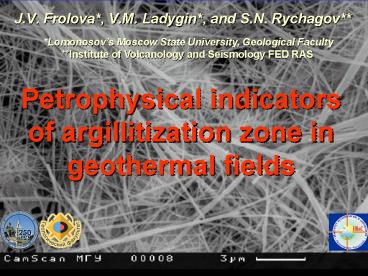Petrophysical indicators of argillitization zone in geothermal fields - PowerPoint PPT Presentation
1 / 30
Title: Petrophysical indicators of argillitization zone in geothermal fields
1
Petrophysical indicators of argillitization zone
in geothermal fields
- J.V. Frolova, V.M. Ladygin, and S.N. Rychagov
Lomonosovs Moscow State University, Geological
Faculty Institute of Volcanology and Seismology
FED RAS
2
Advantages of petrophysical analysis
- Laboratory measurements of physical and
mechanical properties are relatively cheap and
not labour-consuming - Petrophysical data submit quantitative
information about condition and homogeneity of
host rocks in geothermal fields and about their
variation - Petrophysical properties help to better
understand evolution and mechanisms of geothermal
process, to determine the main stages. - They help to obtain some additional information
about geothermal field structure and its
component units. - They assist to geophysical log interpretation
(density gravity survey, magnetic
susceptibility magnetic survey, velocity of
elastic waves seismic survey) - Physical properties (density, porosity,
permeability, thermal characteristics) are
necessary as input data for numerical modeling of
geothermal process. - Mechanical properties bring useful information
during drilling and are helpful for prediction of
rocks fracturing during development and
exploitation of geothermal reservoir.
3
The database of volcanic rocks hosted geothermal
systems
- Geological part
- region, age, burial depth, rock, genesis
- Petrographical part
- chemical and mineral composition, structure,
type of cement, type and magnitude of secondary
alterations images of thin sections, polished
sections, SEM data of x-ray, termogravimetric,
microprobe analyses - Petropysical part
- bulk density, specific density, total
porosity, effective porosity by air, effective
porosity by water, permeability, hygroscopy,
sonic velocity, uniaxial strength, thermal
characteristics, magnetic susceptibility,
deformational properties properties under high
PT conditions
4
Schematic models of a geothermal system
Taken from the book Geothermal energy.
Utilization and technology Edited by Mary H.
Dickson and Mario Fanelli, 2003
5
Petrophysical properties
- Hygroscopy (Wg)
- Reflects the content and type of clays
- Easy and cheap to determine in a lab
- Rock cuttings can be used
- Velocity of longitudinal waves
- in dry (Vp) and water-saturated (Vpw)
environments - KVp(Vpw-Vp)/Vp100,
- Cheap and easy measurement
- - It is necessary to have core samples
6
Objects Pauzhetsky (1) and Okeansky (2)
geothermal fields
7
The Pauzhetsky geothermal field Southern
Kamchatka
8
Location of the Pauzhetsky geothermal field
9
Geological section of the Pauzhetsky geothermal
field
It is composed of Neogene-Quaternary
volcano-clastic rocks alternating with lava flows
and dykes
10
Hydrothermal zones (T up to 180-200 oC)
- Argillization (down to 60-120 m)
- (smectite, mordenite, heulandite,
- clinoptilolite, opal, tridymite)
- Zeolitization
- (laumontite and corrensite)
- Propylitic
- (chlorite, calcite and sericite, epidote,
- prehnite)
- Boiling zones (developed in some faults and
fracture zones and composed of quartz and
adularia)
11
Geological section of the Pauzhetsky geothermal
field
The Upper Pauzhetka series fine-medium grained
glassy tuffs influenced by argillitization
Caprocks
12
Glassy tuffs (N23-Q1 pau3). Outside the
geothermal field
Thin section images
SEM images
13
Inside the geothermal fieldArgillized tuffs
(N23-Q1 pau3).
Thin section images
Pl
Vitreous matrix
Vitreous matrix, glass grains, and partially Pl
glass grains
Smectite, opal, tridymite, zeolites (mordenite,
clinoptilolite, heulandite)
14
Average well production rate vs. depth
Properties of argillized tuffs
15
SEM imagesSmectite-zeolite matrix
Sm
Z
Smectite and high-silica zeolites are
characterized by microporosity which is
ineffective for fluid flow
16
Substitution of vitreous matrix by zeolites and
smectite
Smectite
Zeolite web
Smectite
17
Substitution of plagioclase by smectite and
zeolites
zeolite
Pl
smectite
18
SEM imagesMicrostructure of clay and zeolite in
argillization zone
zeolite
zeolite
smectite
smectite
19
Borehole 21
Wg,
Wg2-3,5
Arg
Zeol
Wglt 1
Prop
20
Borehole 20
Wg,
Wg1,5-5
Arg
Zeol
Wglt 1,2
Prop
21
Borehole 13
Wg,
Arg
Wg2-3,2
Zeol
Wglt 1,2
Prop
22
Hygroscopy distribution and argillization zone
definition
Argillization zone
Wggt1,5-2
Wglt1-1,2
23
Okeansky geothermal field,Iturup island,Slope
of volcano Baranskogo
24
Geological section of the Okeansky geothermal
field
N2-Q1 lb
N2 pr
It is high temperature hydrothermal system (T up
to 300-320 0C at a depth of about 1-1,2 km data
of thermal logging) hosted in Neogene-Quaternary
volcanoclastic rocks interbanded with lavas. A
shallow subvolcanic body is assumed to be the
heat source of the hydrothermal system.
25
Okeansky geothermal field Hydrothermal zones (T
gt 300 oC)
- Acid sulfate leaching
- (opal, tridymite, ferric oxide, kaolinite,
alunite) - Argillization 1
- (smectite, high-silica zeolites, opal)
- Argillization 2
- (mixed layered with smectite component,
calcite) - Zeolitization
- Propylitic
- (chlorite, quartz, wairakite, albite,
epidote, sericite) - Secondary quartzites
1,2 km
26
Okeansky geothermal field. Hygroscopy
distribution and argillization zone definition
Acid sulfate leaching
Argillization zone
Wg 1-7
Porosity 30-45 Gas permeability 0,01-0,9 mD
27
KVp(Vpw-Vp)/Vp100,
Vp - velocity of longitudinal waves in dry
rockVpw - velocity of longitudinal waves in
water-saturated rock
- Positive values indicate microfractures and open
pores within a rock - Negative values indicate high content of clay
minerals - 0 is indicative either dense and massive rock
without pores and fractures or a balance between
two cases mentioned above
28
The change of Kvp along borehole 54 in the
Okeanskoe geothermal field
Kvplt0 Wggt2
KVp(Vpw-Vp)/Vp100
Correlation between Kvp and Wg
Kvpgt0 Wglt1
29
Conclusion
- Petrophysical studies in two geothermal fields
of the Kuril-Kamchatka island arc leads to the
following conclusions - The argillization zone (potentially impermeable
caprock) can be easily predicted through rocks
hygroscopy Hygroscopy above 1.5-2 are typical
for the argillization zone. - A decrease of sonic velocity through rocks after
saturation by water (negative KVp ) correlates
with high hygroscopy and can be used as an
indicator of the argillization zone in geothermal
fields
30
Thank you for attention!































